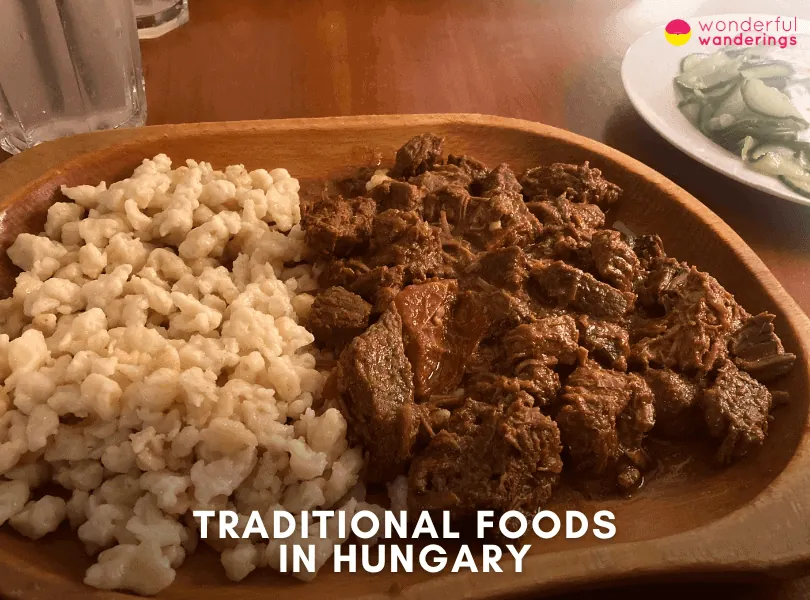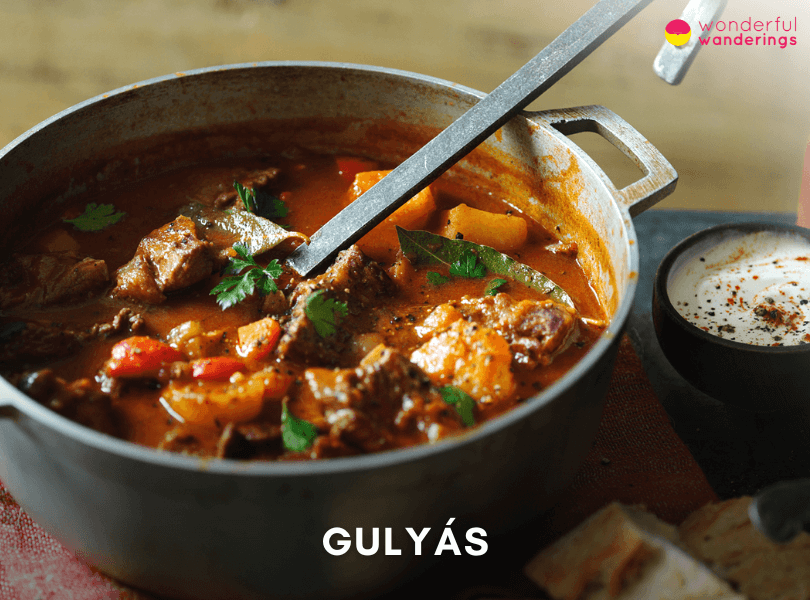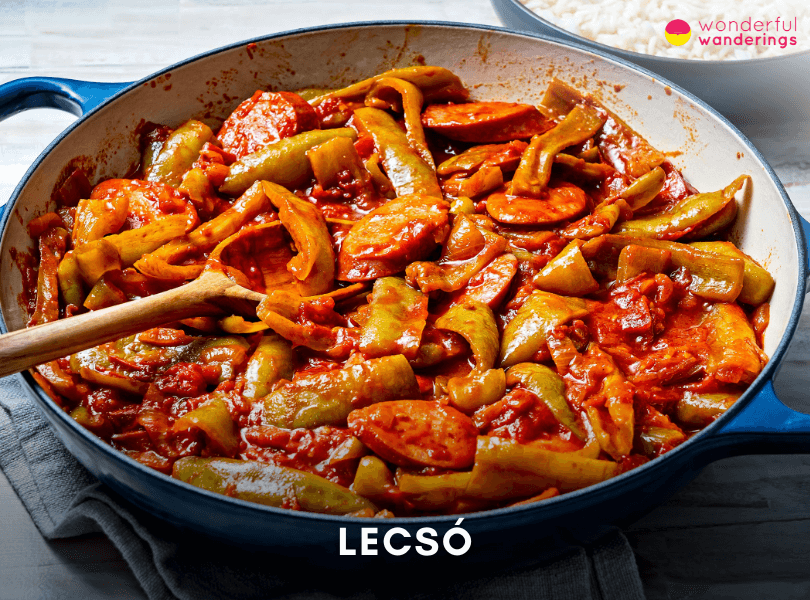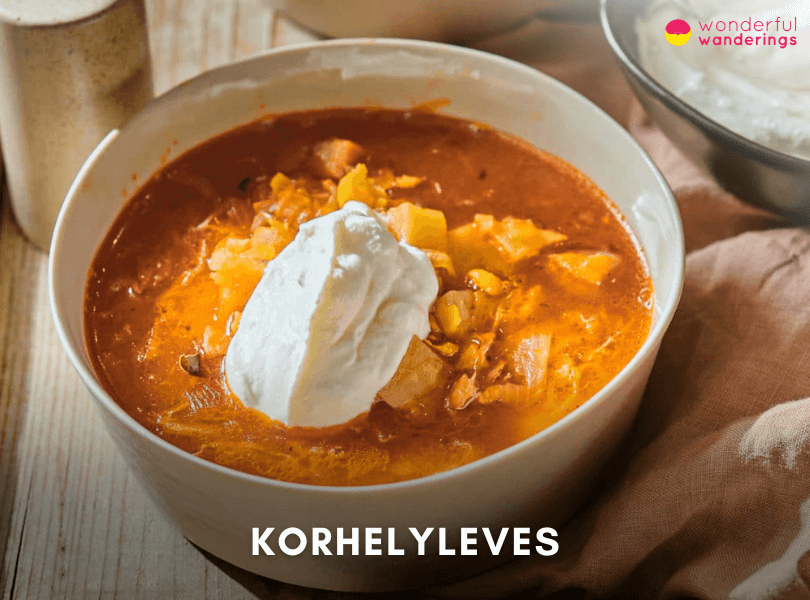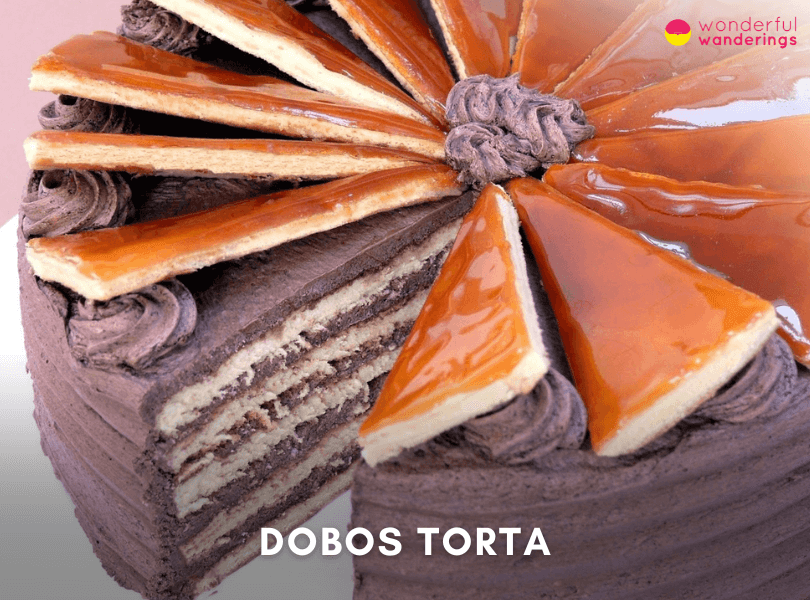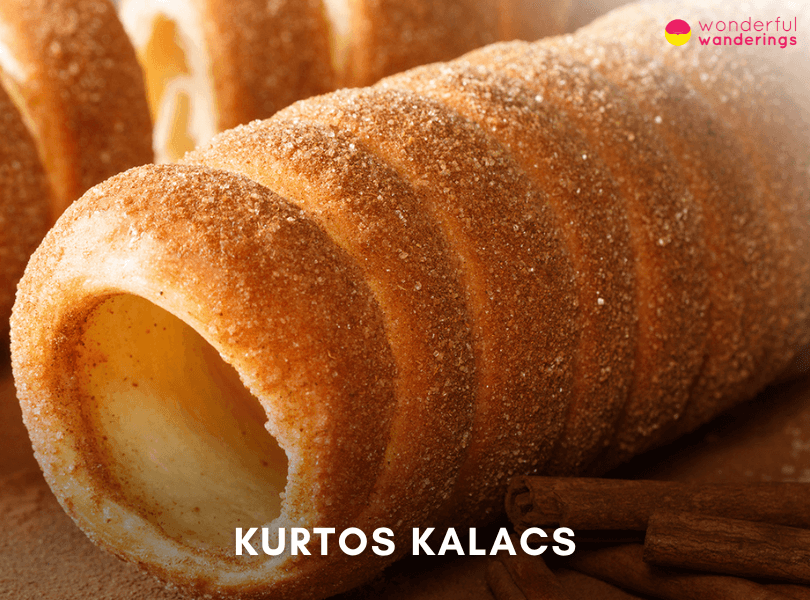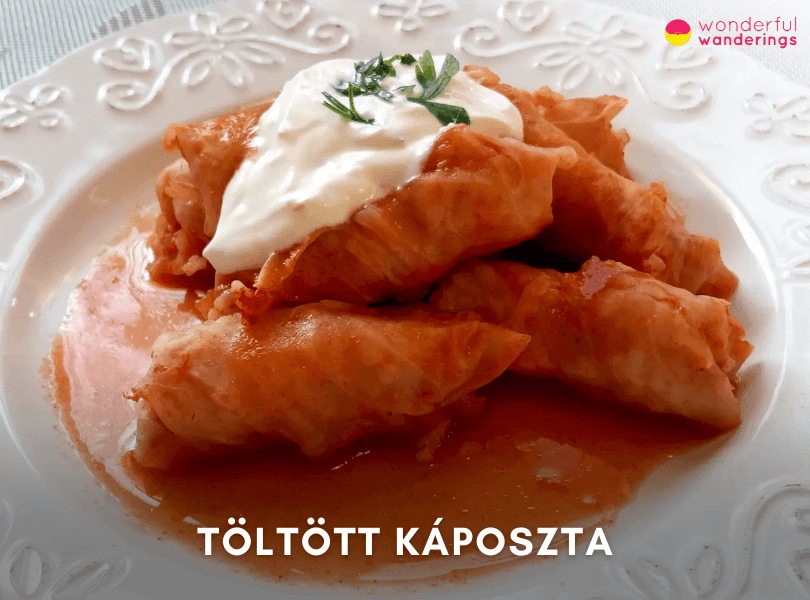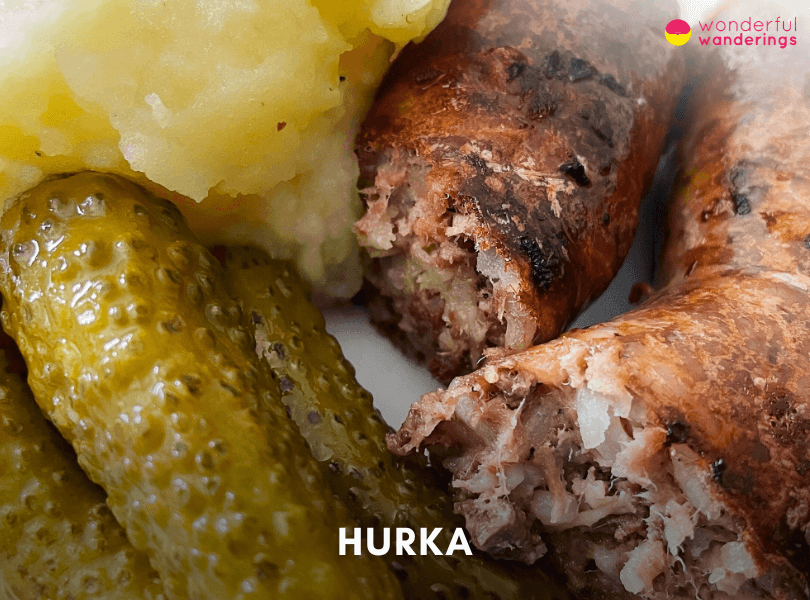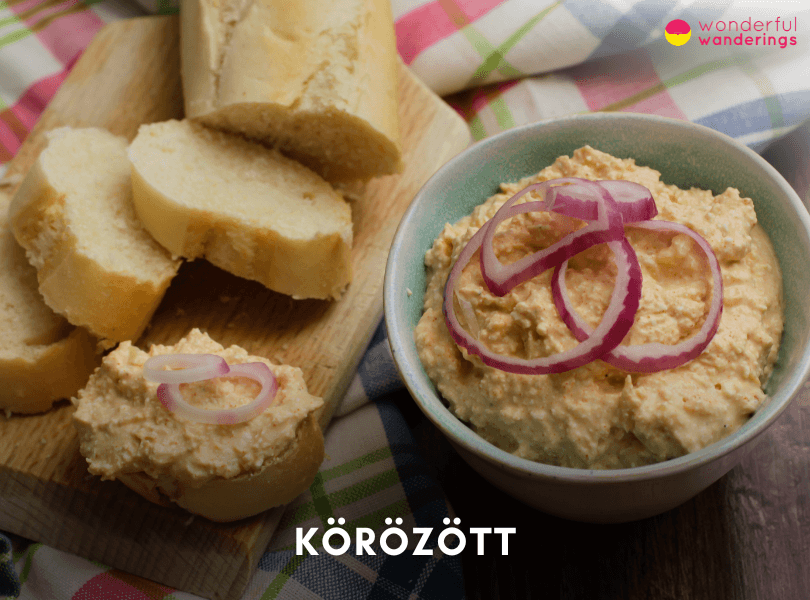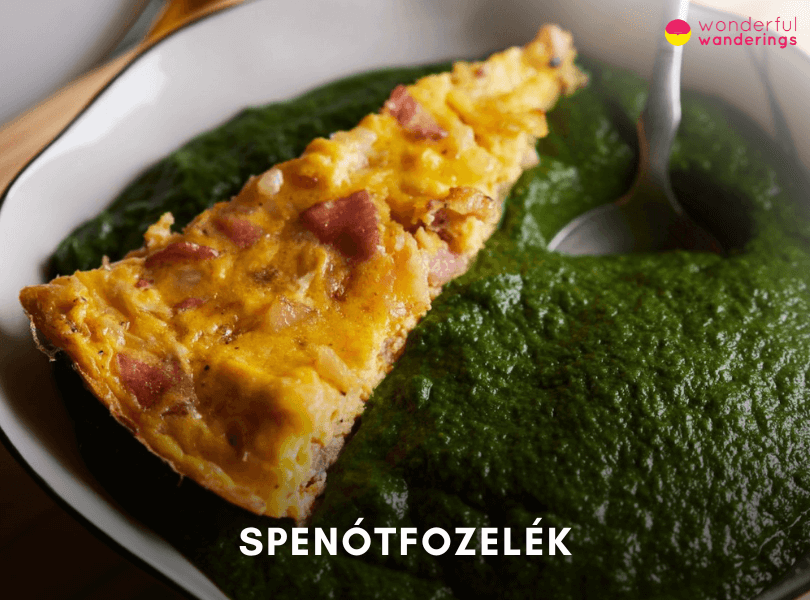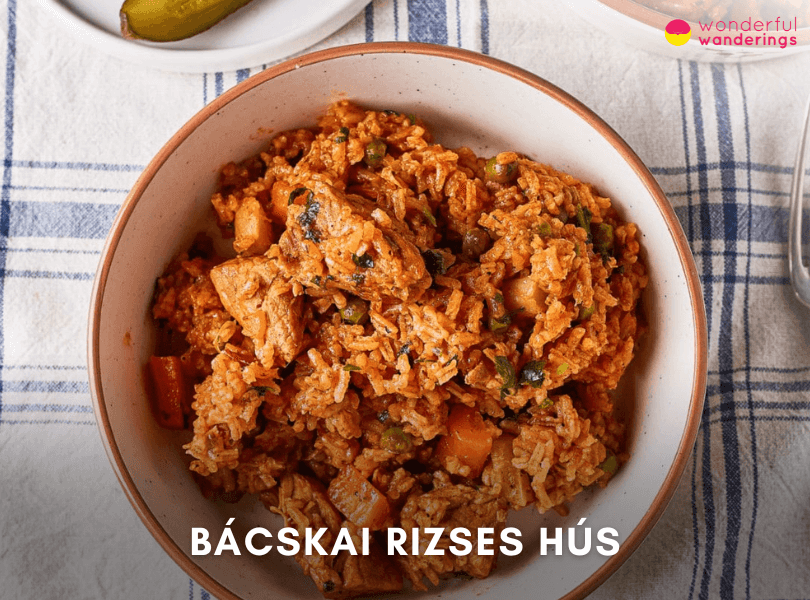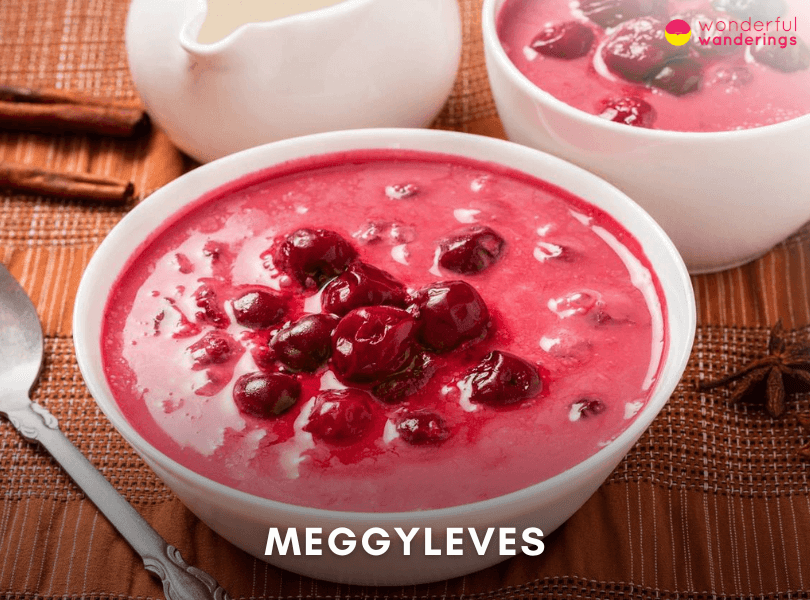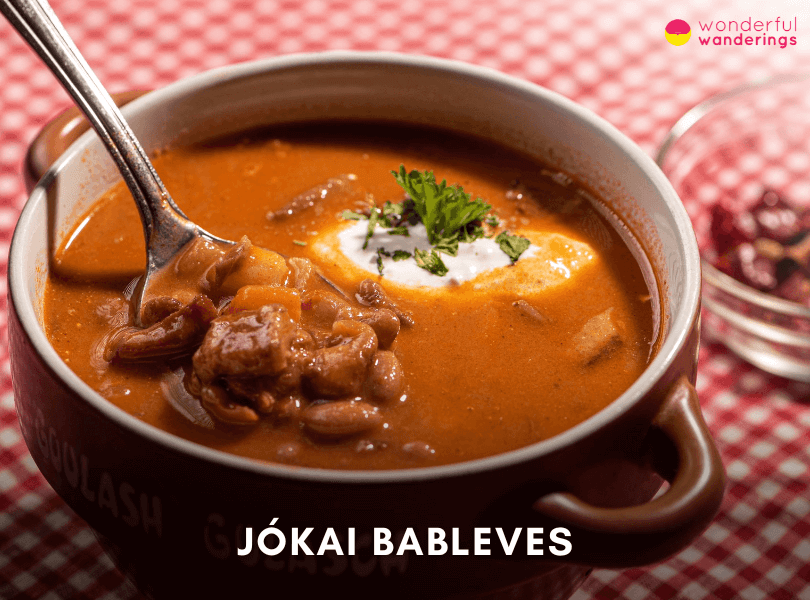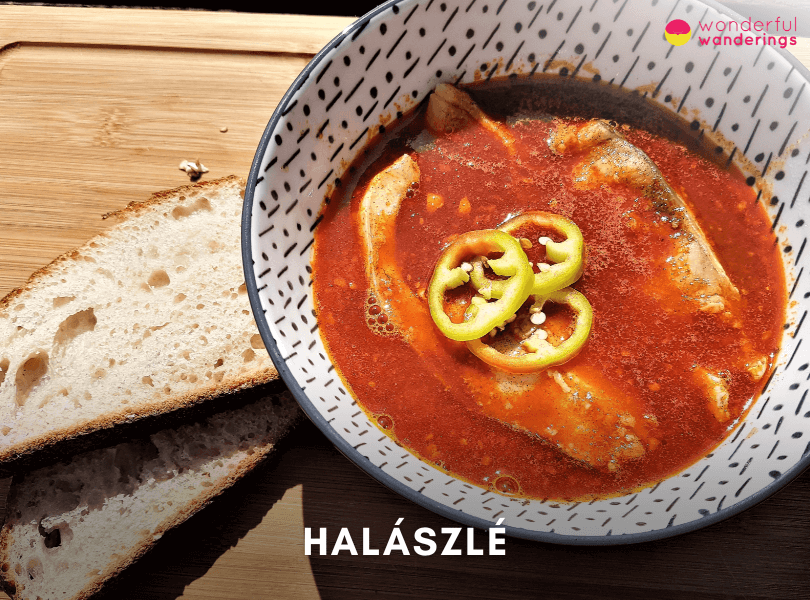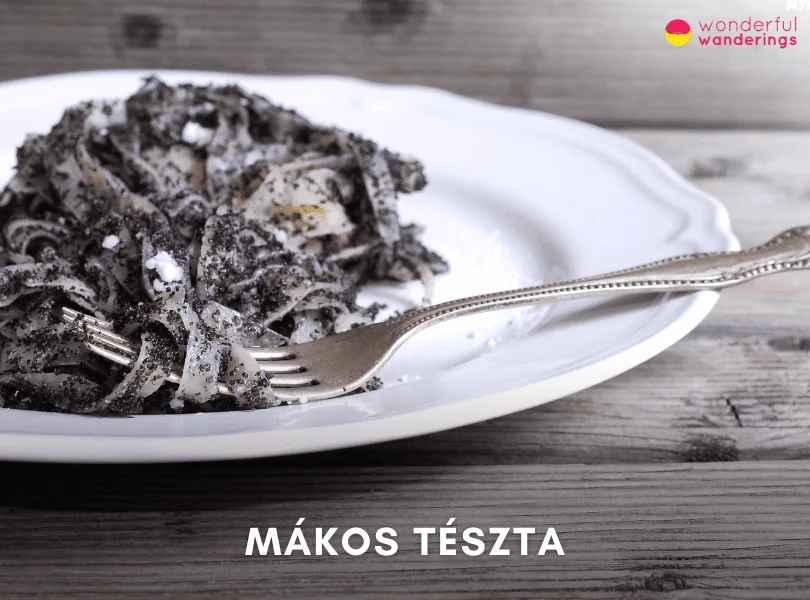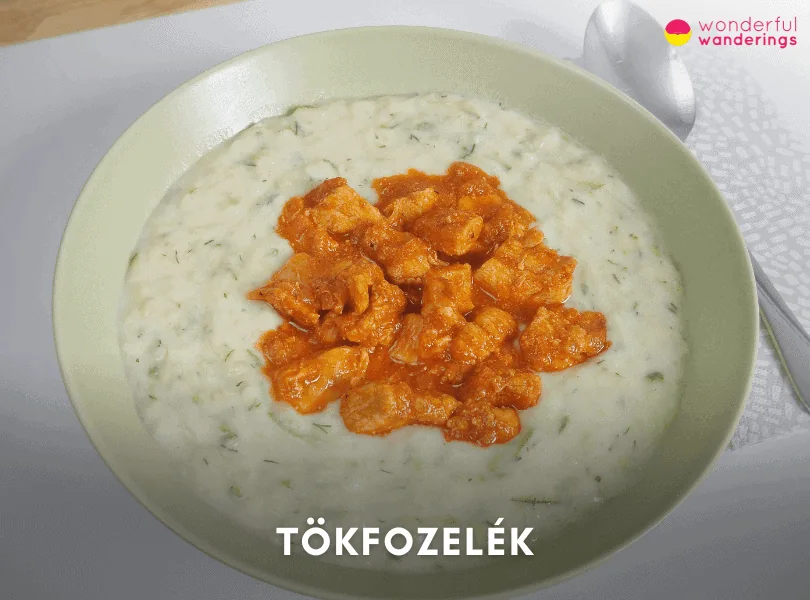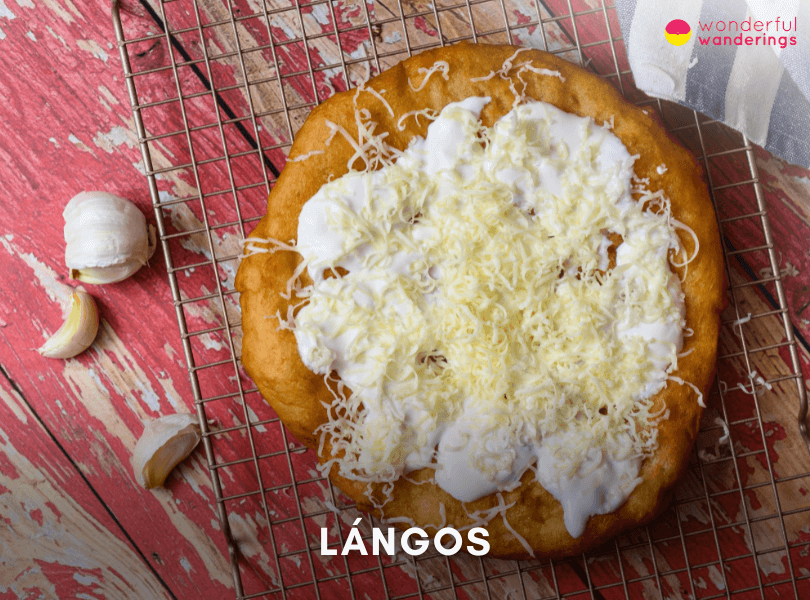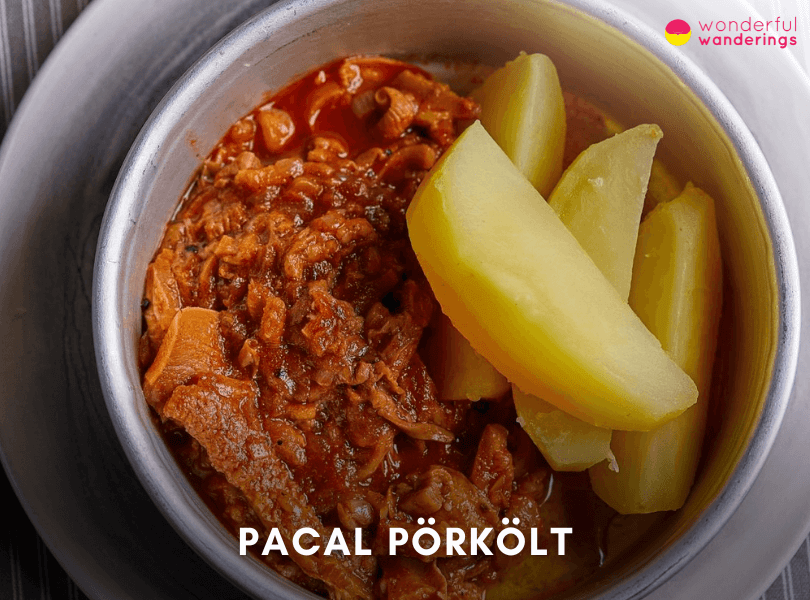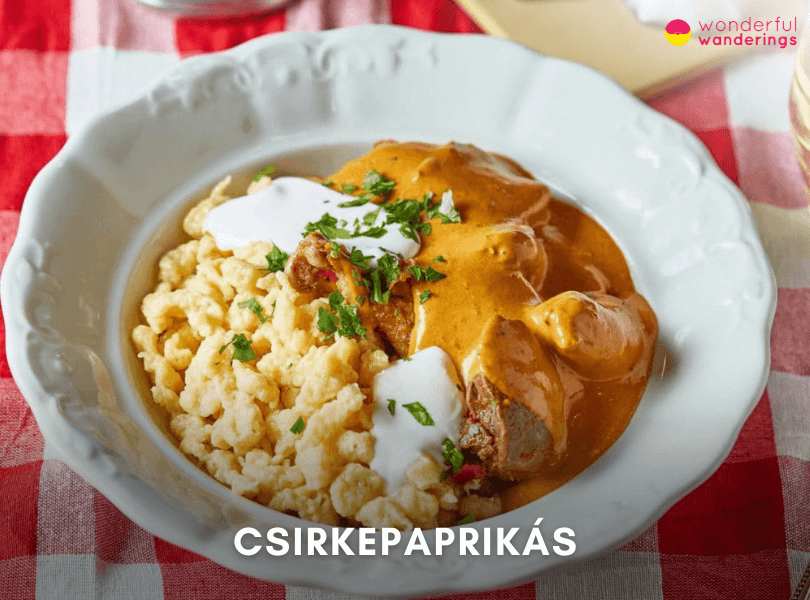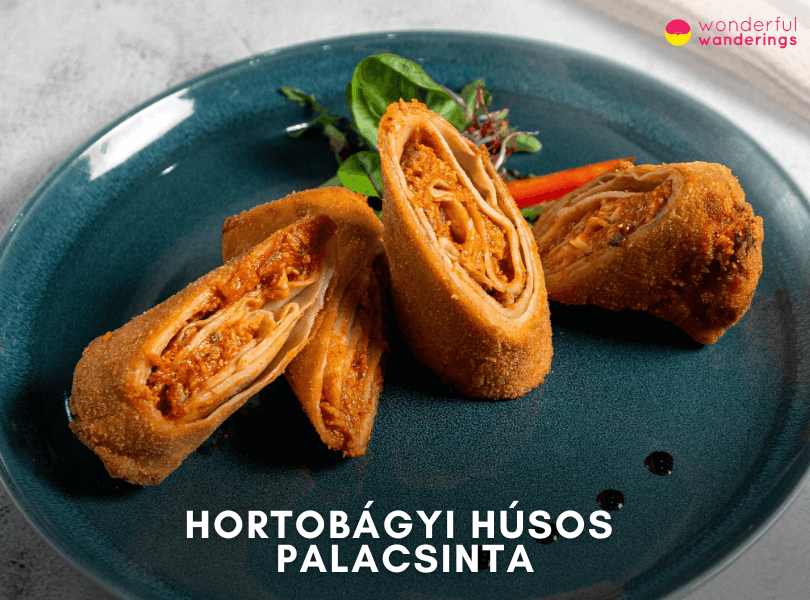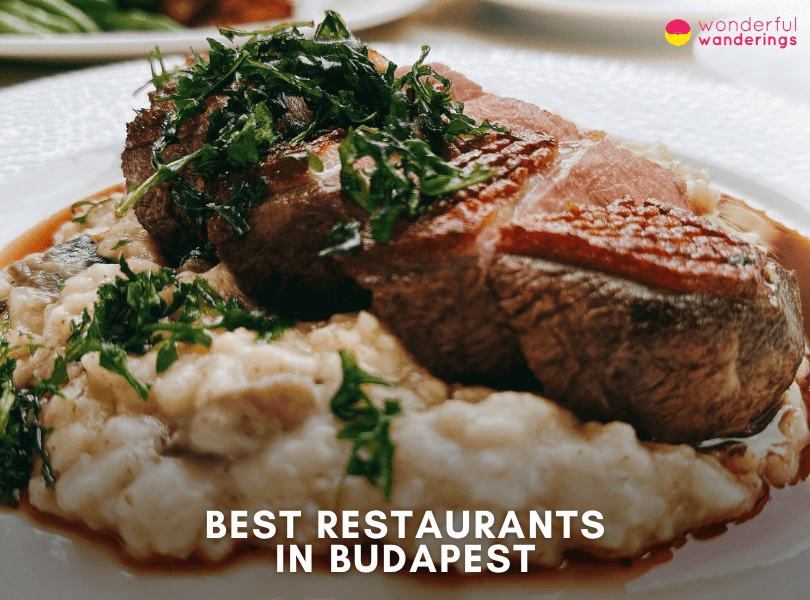Hungary is a country with a rich culinary heritage, influenced by its neighbors and its history. Hungarian food is known for using paprika, a spice that gives many dishes a distinctive red color and a mild or hot flavor. Some of the most traditional Hungarian dishes are hearty soups, stews and casseroles, often made with meat, potatoes, vegetables and cheese. Hungarian desserts are also popular, especially pastries, cakes and crepes. Budapest, the capital of Hungary, offers a wide range of restaurants, cafes and markets where visitors can taste the local cuisine.
Listed below are the traditional Hungarian foods.
- Gulyás. Gulyás, also known as Hungarian Goulash, is a popular traditional Hungarian dish. It is a hearty stew made with beef, onions, paprika and various vegetables. Gulyás is typically a main course and is enjoyed for its rich flavors and comforting qualities.
- Lecsó. Lechó is a famous Hungarian food that is commonly enjoyed in Budapest. It is a simple and flavorful dish made from tomatoes, peppers, onions and sometimes garlic. These ingredients are cooked together until they form a thick stew-like consistency. Lechó is typically served hot and can be enjoyed as a main course or a side dish.
- Korhelyleves. Korhelyleves, a famous Hungarian food, is a hearty soup traditionally consumed to ease the effects of a hangover. It is typically made with simple ingredients like sauerkraut, smoked meats (such as sausage or bacon) and potatoes. The soup is served hot in a bowl and often accompanied by a slice of crusty bread.
- Dobos Torta. Dobos Torta is a famous Hungarian dessert known for its layered structure and rich flavor. It comprises several thin sponge cake layers filled with rich chocolate buttercream and a caramel glaze. The cake is traditionally garnished with wedges of caramelized sugar, which add a crunchy texture to each slice.
- Kurtos Kalacs. Kurtos Kalacs, also known as Chimney Cake, is a famous Hungarian pastry popular for its distinctive shape and sweet flavor. It is made by wrapping a dough strip around a cylindrical spit and baking it over an open fire or in a specialized oven. As it bakes, the dough becomes golden and crispy on the outside while remaining soft and fluffy on the inside.
- Töltött Káposzta. Töltött Káposzta, also known as stuffed cabbage, is a famous Hungarian dish known for its hearty and comforting flavors. It is made by wrapping ground meat, rice, onions and spices in blanched cabbage leaves and then cooking the rolls in a flavorful tomato-based sauce.
- Hurka. Hurka is a famous Hungarian food known for its sausage-like appearance and savory taste. It is a sausage from pork meat, rice or barley, spices and blood or liver. The ingredients are combined and stuffed into a casing, typically made from the pig’s intestines, then cooked until firm and flavorful.
- Körözött. Körözött is a famous Hungarian food that is often referred to as “Hungarian cheese spread”. It is a savory spread made from soft cheese, butter, paprika and onions. The ingredients are blended to create a creamy and flavorful mixture, which is then typically served as a spread on bread or crackers.
1. Gulyás
Gulyás, also known as Hungarian Goulash, is a popular traditional Hungarian dish. It is a hearty stew made with beef, onions, paprika and various vegetables. Gulyás is typically a main course and is enjoyed for its rich flavors and comforting qualities. The ingredients used in Gulyás include tender beef, typically from the shoulder or shank, which is cut into cubes. The meat is then cooked with onions, garlic and a generous amount of paprika, which gives the dish its distinct red color and smoky flavor. The other common ingredients include potatoes, carrots, bell peppers and tomatoes, which add texture and depth to the stew. Gulyás is seasoned with salt, pepper and sometimes caraway seeds for additional flavor. Gulyás is traditionally cooked in a large pot over an open fire or stove. The dish simmers until the meat is tender and the flavors have melded together. It is often served with a side of bread or noodles to soak up the flavorful broth. Gulyás is a satisfying and filling dish, perfect for chilly days.
Gulyás can be a nutritious meal as it contains a variety of vegetables and lean beef. The dish can be high in calories, especially if it is made with fatty cuts of meat or served with large portions of bread or noodles. Moderation is key when enjoying Gulyás as part of a balanced diet. There are different variations of Gulyás across Hungary and even within Budapest. Some variations include adding ingredients like sauerkraut, sour cream or different types of meat such as pork or venison. Each region and family may have their unique twist on the recipe, but the core elements of beef, onions, paprika and vegetables remain consistent. In Budapest, Gulyás can be found in many traditional Hungarian restaurants and eateries throughout the city. Popular places to try Gulyás include traditional Hungarian taverns, known as “csárda”, and restaurants specializing in Hungarian cuisine. Visitors to Budapest can enjoy a bowl of Gulyás for 8€ ($8.72, £6.96) to 12€ ($13.08, £10.44).
2. Lecsó
Lechó is a famous Hungarian food that is commonly enjoyed in Budapest. It is a simple and flavorful dish made from tomatoes, peppers, onions and sometimes garlic. These ingredients are cooked together until they form a thick stew-like consistency. Lechó is typically served hot and can be enjoyed as a main course or a side dish. Lechó is a nutritious option. It is low in calories and fat and the vegetables used in its preparation provide essential vitamins and minerals, but the overall healthiness of the dish can vary depending on the amount of oil or other ingredients used in the cooking process.
There are different variations of Lechó that can be found across Hungary. Some recipes may include additional ingredients such as paprika, sausages or bacon to enhance the flavor. These variations add a savory and smoky element to the dish. The basic ingredients of tomatoes, peppers, onions and garlic remain consistent. When visiting Budapest, Most traditional Hungarian restaurants and eateries in the city offer this dish as part of their menu. Local markets and food stalls often serve Lechó as a popular street food option. Visitors can expect to pay 5€ ($5.45, £4.35) to 10€ ($10.9, £8.7) for a serving of Lechó.
3. Korhelyleves
Korhelyleves, a famous Hungarian food, is a hearty soup traditionally consumed to ease the effects of a hangover. It is typically made with simple ingredients like sauerkraut, smoked meats (such as sausage or bacon) and potatoes. The soup is served hot in a bowl and often accompanied by a slice of crusty bread. It is not a healthy dish due to its high-fat content, but is cherished for its comforting qualities. There are several variations of Korhelyleves, each with its unique twist. Some recipes include additional ingredients like beans, onions or carrots to enhance the flavor and texture, while others may incorporate sour cream or vinegar to add a tangy kick. Despite these variations, the core components of sauerkraut, smoked meats and potatoes remain consistent. In Budapest, Korhelyleves can be found in various traditional Hungarian restaurants and eateries. Most establishments in the city center offer this dish as part of their menu. Visitors can expect to pay 8€ ($8.72, £6.96) to 12€ ($13.08, £10.44) for a serving of Korhelyleves.
4. Dobos Torta
Dobos Torta is a famous Hungarian dessert known for its layered structure and rich flavor. It comprises several thin sponge cake layers filled with rich chocolate buttercream and a caramel glaze. The cake is traditionally garnished with wedges of caramelized sugar, which add a crunchy texture to each slice. The main ingredients used in Dobos Torta include flour, eggs, sugar, butter, cocoa powder and chocolate. The sponge cake layers are made by baking a thin batter of these ingredients. The chocolate buttercream is prepared by combining melted chocolate, butter and sugar to create a smooth and creamy filling. The caramel glaze is made by heating sugar until it caramelizes and then spreading it over the top layer of the cake. Dobos Torta is typically served in rectangular slices, making the layers visible. The cake is often enjoyed as a dessert during special occasions and celebrations. It pairs well with a cup of coffee or tea, complementing its richness with a warm and aromatic beverage.
Dobos Torta is an indulgent treat rather than a health-conscious option. It is high in calories, sugar and fat due to its rich ingredients, making it a dessert best enjoyed in moderation. The classic version of Dobos Torta remains popular, but variations of the cake incorporate different flavors. Some variations include adding layers of fruit preserves, such as apricot or raspberry, between the sponge cake layers. The other variations may feature additional fillings, such as whipped cream or nut-based creams, to enhance the taste and texture of the cake. Dobos Torta can be found in various pastry shops, cafes and restaurants throughout Budapest. Popular establishments serving this iconic Hungarian dessert include Café Gerbeaud, Ruszwurm Confectionery and Szamos Gourmet Palace.
5. Kurtos Kalacs
Kurtos Kalacs, also known as Chimney Cake, is a famous Hungarian pastry popular for its distinctive shape and sweet flavor. It is made by wrapping a dough strip around a cylindrical spit and baking it over an open fire or in a specialized oven. As it bakes, the dough becomes golden and crispy on the outside while remaining soft and fluffy on the inside. The main ingredients used in Kurtos Kalacs include flour, sugar, butter, yeast and milk. The dough is prepared by combining these ingredients and allowing it to rise. Once the dough has risen, it is divided into strips wrapped around the cylindrical spit. The pastry is typically coated with sugar, which caramelizes during baking, giving the cake a sweet and crunchy exterior. Kurtos Kalacs is commonly served as a street food snack or dessert. It is often enjoyed plain, allowing the natural flavors of the dough and caramelized sugar to shine. It can also be served with various toppings and fillings, such as cinnamon, cocoa powder, chopped nuts or grated cheese, adding flavors and textures to the pastry.
Kurtos Kalacs is an indulgent treat rather than a nutritious choice. It is high in calories and sugar due to its dough and sugar coating, making it a dessert that should be enjoyed in moderation. The classic version of Kurtos Kalacs is the most well-known, but there are also variations of the pastry that incorporate different ingredients and flavors. Some variations may include adding fillings such as chocolate, Nutella or fruit preserves inside the hollow center of the cake, while others may feature savory versions with toppings like cheese or garlic. Kurtos Kalacs can be found in various street food stalls, markets and pastry shops in Budapest. Some popular places to enjoy this traditional Hungarian treat include the Great Market Hall, Hold Street Market and the food stalls along Váci Street.
6. Töltött Káposzta
Töltött Káposzta, also known as Stuffed Cabbage, is a famous Hungarian dish for its hearty and comforting flavors. It is made by wrapping ground meat, rice, onions and spices in blanched cabbage leaves and then cooking the rolls in a flavorful tomato-based sauce. The main ingredients used in Töltött Káposzta include cabbage, ground meat (often a combination of pork and beef), rice, onions, garlic, paprika and tomatoes. The cabbage leaves are blanched to soften them, making them easier to roll and ensuring a tender texture. The meat and rice filling is seasoned with a blend of spices, including paprika, to enhance the dish’s taste. The rolls are then placed in a pot or baking dish, covered with tomato sauce and simmered or baked until the flavors meld together. Töltött Káposzta is typically served hot as a main course. The cabbage rolls are placed in a bowl or on a plate and the tomato sauce is spooned over them, providing a rich and savory coating. The dish is often accompanied by sour cream, which adds a creamy and tangy element to balance the flavors. It is commonly enjoyed with a side of crusty bread or potatoes, allowing diners to soak up the delicious sauce.
Töltött Káposzta is a hearty and filling dish. It contains nutritious ingredients such as cabbage and onions but is also high in calories and fat due to the ground meat. The overall healthiness of the dish can vary depending on the cooking methods and portion sizes. There are different variations of Töltött Káposzta across Hungary and its neighboring countries. Some variations may use different types of meat, such as lamb or veal, in the filling. Some may incorporate additional ingredients like sauerkraut, mushrooms or diced vegetables to add depth of flavor. Vegetarian versions of the dish can be made by replacing the meat with plant-based alternatives or using a filling composed of rice, beans and vegetables. Töltött Káposzta can be found in traditional Hungarian restaurants, local eateries and home-style taverns in Budapest. Some popular places to enjoy this classic Hungarian dish include Rosenstein Restaurant, Kiskakukk Étterem and Fülemüle Étterem.
7. Hurka
Hurka is a famous Hungarian food known for its sausage-like appearance and savory taste. It is a sausage from pork meat, rice or barley, spices and blood or liver. The ingredients are combined and stuffed into a casing, typically made from the pig’s intestines, then cooked until firm and flavorful. The main ingredients used in Hurka include pork meat, rice or barley, spices (such as salt, pepper and paprika) and blood or liver. The pork meat is ground or finely chopped and the rice or barley is cooked before being added to the mixture. The spices are added to enhance the flavor profile of the sausage. The blood or liver is optional but adds richness and depth to the taste. Hurka is usually served as a main dish or as part of a hearty Hungarian breakfast. It can be cooked in various ways, such as grilling, frying or boiling. When served, it is typically sliced into rounds or oblong pieces. It is often enjoyed with mustard or pickles as condiments, which provide a tangy contrast to the rich and savory flavors of the sausage.
Hurka is a high-protein food but can be high in fat due to pork meat and blood or liver use. There are different variations of Hurka across Hungary. Some variations may include using different types of meat, such as beef or veal, in addition to or instead of pork, while other variations may incorporate additional ingredients like onions, garlic or various herbs and spices to add complexity to the flavor. Hurka can be found in traditional Hungarian butcher shops, markets and some local restaurants in Budapest. Some popular places to enjoy this classic Hungarian sausage include Belvárosi Disznótoros, Budapesti Csarnok and Székely Csárda.
8. Körözött
Körözött is a famous Hungarian food that is often referred to as “Hungarian cheese spread”. It is a savory spread made from soft cheese, butter, paprika and onions. The ingredients are blended to create a creamy and flavorful mixture, which is then typically served as a spread on bread or crackers. The main ingredients used in Körözött include soft cheese (such as quark or cottage cheese), butter, paprika (often Hungarian sweet paprika) and onions. The cheese is mashed or blended until smooth and the butter is added to create a creamy consistency. Paprika is added for spice and color, while onions provide a savory and aromatic flavor. Depending on personal preferences, seasonal ingredients such as salt, pepper and garlic may also be included.
Körözött is commonly served as an appetizer or snack. It is typically spread on slices of bread or crackers, providing a rich and tangy flavor. The spread can be garnished with fresh herbs, such as parsley or dill, for added freshness and visual appeal. It is enjoyed as part of a meal or as a standalone dish during social gatherings or parties. Körözött is a flavorful and indulgent food. It contains nutritious ingredients such as cheese and onions, it is also high in fat due to the presence of butter.
There are different variations of Körözött across Hungary. Some variations may include adding chopped or grated vegetables, such as bell peppers or cucumbers, to add freshness and texture. Some may incorporate herbs and spices, such as caraway seeds or chives, for additional flavor profiles. Some popular places in Budapest to enjoy this classic Hungarian cheese spread include Central Market Hall, Gerbaud Café and Szimpla Kert Ruin Bar.
9. Spenótfozelék
Spenótfozelék is a famous Hungarian food known as “spinach stew”. It is a traditional dish made from spinach, onions, flour, milk and spices. The ingredients are cooked together to create a thick and creamy stew-like consistency, which is then typically served as a main course. The main ingredients used in Spenótfozelék include spinach, onions, flour, milk, butter, salt and pepper. The spinach is washed and chopped before being cooked with onions in butter until tender. Flour is added to create a roux, followed by milk thickening the mixture. The dish is seasoned with salt and pepper to taste, enhancing the flavors of the spinach.
Spenótfozelék is usually served as a main course accompanied by boiled potatoes or bread. The stew-like consistency makes it suitable for spooning onto the side of the plate. It can also be enjoyed on its own as a vegetarian dish. The creamy texture and savory taste of the stew complement the earthiness of the spinach, creating a comforting and satisfying meal. Spenótfozelék is a nutritious dish. Spinach is a good source of vitamins, minerals and antioxidants. It is low in calories and fiber, making it a healthy choice.
There are different variations of Spenótfozelék across Hungary. Some variations may incorporate additional ingredients such as garlic, sour cream or grated cheese for added flavor and richness, while others may include different vegetables or herbs to enhance the taste and texture of the stew. Spenótfozelék can be found in traditional Hungarian restaurants and some local eateries and cafeterias in Budapest. Some popular places to enjoy this classic Hungarian spinach stew include Rosenstein Restaurant, Két Szerecsen and Kádár Étkezde.
10. Bácskai Rizses Hús
Bácskai Rizses Hús is a famous Hungarian food called “Bácska-style meat with rice”. It is a traditional dish consisting of tender pieces of meat, rice, onions, peppers, tomatoes and spices. The ingredients are cooked together to create a flavorful and hearty main course. The main ingredients used in Bácskai Rizses Hús include meat (typically pork or chicken), rice, onions, peppers (bell peppers or Hungarian wax peppers), tomatoes, paprika, salt and pepper. The meat is cut into bite-sized pieces and cooked with onions and peppers until soft and fragrant. Rice is then added and cooked together with the meat and vegetables. Tomatoes and paprika are added for a tangy and spicy flavor. The dish is seasoned with salt and pepper to taste. Bácskai Rizses Hús is usually served as a main course accompanied by pickles or salad. The meat, rice and vegetables are combined into a flavorful and filling dish. The dish is typically garnished with fresh herbs, such as parsley, for added freshness and visual appeal. It is a complete meal, balancing protein, carbohydrates and vegetables.
Bácskai Rizses Hús can be a nutritious dish depending on the type and cut of meat used. Lean cuts of pork or chicken can be a good source of protein. The inclusion of vegetables like peppers and tomatoes adds vitamins and minerals to the dish. There are different variations of Bácskai Rizses Hús across Hungary. Some variations may include using different types of meat, such as beef or lamb, in addition to or instead of pork or chicken. Some may incorporate additional vegetables or spices to create different flavor profiles. The popular places to enjoy this classic Hungarian meat and rice dish include Rosenstein Restaurant, Két Szerecsen and Mátyás Pince.
11. Meggyleves
Meggyleves is a famous Hungarian food known as “sour cherry soup”. It is a traditional dish made from sour cherries, sugar, water, cinnamon, cloves, lemon zest and sometimes cream. The ingredients are cooked together to create a sweet and tangy soup-like consistency, which is typically served as a chilled dessert or appetizer. The main ingredients used in Meggyleves include sour cherries, sugar, water, cinnamon, cloves and lemon zest. The sour cherries are pitted and cooked in water with sugar, resulting in a sweet and slightly tart base. Cinnamon and cloves are added for warm and aromatic flavors, while lemon zest provides a bright and citrusy note. Some variations of Meggyleves may also include cream for added richness and creaminess. Meggyleves is traditionally served chilled, making it a refreshing summer dessert or appetizer. It is typically garnished with a sour or whipped cream dollop for added creaminess and visual appeal. The soup is poured into bowls or glasses and served cold, allowing the flavors to meld together. It can be enjoyed independently or accompanied by a sweet pastry or cookie.
Meggyleves can be a relatively healthy dessert option. Sour cherries are a good source of antioxidants and vitamins; however, the overall healthiness of the dish can vary depending on the amount of sugar and cream used in the recipe. It is recommended to enjoy Meggyleves in moderation as part of a balanced diet. There are different variations of Meggyleves across Hungary. Some variations may include adding other fruits, such as strawberries or raspberries, to create a mixed fruit soup. Some may incorporate different spices or herbs to enhance the flavors. Some popular places to enjoy this classic Hungarian sour cherry soup include Gerbeaud Café, Central Café and Café Ruszwurm.
12. Jókai Bableves
Jókai Bableves is a famous Hungarian food called “Jókai bean soup”. It is a traditional dish made from kidney beans, smoked pork, onions, paprika, tomatoes and spices. The ingredients are cooked together to create a flavorful and hearty soup-like consistency, which is typically served as a main course. The main ingredients used in Jókai Bableves include kidney beans, smoked pork (such as bacon or ham hock), onions, paprika, tomatoes, garlic, bay leaves and salt. The kidney beans are soaked overnight and cooked with smoked pork until tender. Onions, paprika, tomatoes, garlic and bay leaves are added to create a rich and savory flavor. The dish is seasoned with salt to taste. Jókai Bableves is usually served as a main course accompanied by bread or a side dish. The soup is typically thick and hearty, with chunks of smoked pork and tender kidney beans. It is garnished with fresh parsley for added freshness and visual appeal. The dish is enjoyed hot, allowing the flavors to meld together and providing a comforting and satisfying meal.
Jókai Bableves can be a nutritious dish. Kidney beans are a good source of protein and fiber. It is recommended to choose lean cuts of smoked pork and to moderate the portion size to maintain a balanced diet. There are different variations of Jókai Bableves across Hungary. Some variations may include adding other vegetables, such as carrots or celery, to enhance the flavor and nutritional profile, while some may incorporate different spices or herbs to create different taste experiences. Jókai Bableves can be found in traditional Hungarian restaurants and some local eateries in Budapest include Rosenstein Restaurant, Két Szerecsen and Mátyás Pince.
13. Halászlé
Halászlé is a famous Hungarian food known as “fisherman’s soup”. It is a traditional dish made from freshwater fish, paprika, onions, garlic, tomatoes and spices. The ingredients are cooked together to create a rich and spicy soup-like consistency, which is typically served as a main course. The main ingredients used in Halászlé include freshwater fish (such as carp, catfish or pike), paprika, onions, garlic, tomatoes, sweet and hot peppers and salt. The fish is typically filleted and cut into pieces, then cooked with onions, garlic and paprika to create a flavorful base. Tomatoes and peppers are added for a tangy and spicy taste. The dish is seasoned with salt and other spices to enhance the flavors.
Halászlé is usually served hot and is traditionally enjoyed in a communal setting. It is served in bowls or deep plates and is accompanied by fresh bread or Hungarian “pogácsa” (savory biscuits). The soup is known for its vibrant red color and rich aroma. It is a comforting and hearty dish, with chunks of tender fish and a spicy broth. Halászlé can be a nutritious option. Freshwater fish is a good source of lean protein and omega-3 fatty acids. Choosing lean fish and moderate portion size is recommended to maintain a balanced diet.
There are different variations of Halászlé across Hungary. The main variation lies in the choice of fish used, as different regions may prefer different types of freshwater fish. Some variations may include adding other vegetables or spices to create different flavor profiles. Some popular places to enjoy this classic Hungarian fisherman’s soup include Fülemüle Étterem, Halászbástya Restaurant and Karcsi Étterem.
14. Somlói Galuska
Somlói Galuska is a famous Hungarian food known as “Somló dumplings”. It is a traditional dessert made from sponge cake, chocolate sauce, vanilla custard, rum, whipped cream and crushed walnuts. The ingredients are layered and assembled to create a decadent and indulgent dessert, which is typically served chilled. The main ingredients used in Somlói Galuska include sponge cake, chocolate sauce, vanilla custard, rum, whipped cream and crushed walnuts. The sponge cake is cut into small cubes and soaked in rum. It is then layered with chocolate sauce and vanilla custard, creating a rich and creamy texture. The dessert is topped with whipped cream and crushed walnuts for added crunch and flavor. Somlói Galuska is typically served chilled in individual bowls or glasses. The layered dessert showcases the contrasting textures and flavors with the moist sponge cake, velvety chocolate sauce, creamy custard, fluffy whipped cream and crunchy walnuts. It is a delightful treat for those with a sweet tooth.
Somlói Galuska is a rich and indulgent dessert. The high sugar and fat content make it a treat to be enjoyed in moderation. It may not be the healthiest option, but it is popular for those looking to indulge in a decadent dessert. Some variations may include adding different types of nuts, such as almonds or hazelnuts, to add variety and texture. Others may incorporate different flavors, such as coffee or fruit syrups, to create different taste experiences. Somlói Galuska can be found in traditional Hungarian restaurants and some local eateries in Budapest. Some popular places to enjoy this classic Hungarian dessert include Café Gerbeaud, Ruszwurm Cukrászda and Auguszt Cukrászda.
15. Mákos Tészta
Mákos Tészta is a famous Hungarian food called “poppy seed pasta”. It is a traditional dessert made from egg noodles, ground poppy seeds, sugar, butter and sometimes milk. The ingredients combine to create a sweet and flavorful dish, typically served as a dessert or a sweet main course. The main ingredients used in Mákos Tészta include egg noodles, ground poppy seeds, sugar and butter. The egg noodles are cooked until tender and mixed with ground poppy seeds, sugar and melted butter. Some variations may include the addition of milk to create a creamier consistency. The dish is known for its unique flavor, with the nutty and slightly sweet taste of the poppy seeds complementing the buttery noodles.
Mákos Tészta is typically served warm or at room temperature. It can be enjoyed as a dessert or a sweet main course. The dish is often garnished with powdered sugar for sweetness and visual appeal. It is a simple yet satisfying dish showcasing the distinct flavor of poppy seeds. Mákos Tészta is a rich and indulgent dessert. The butter’s high sugar and fat content make it a treat to be enjoyed in moderation. It may not be the healthiest option, but it is popular for those looking to satisfy their sweet tooth.
There are different variations of Mákos Tészta across Hungary. Some variations may include adding other ingredients, such as raisins or lemon zest, to enhance the flavor profile, while others may incorporate different types of sweet sauces or syrups to add variety. Mákos Tészta can be found in traditional Hungarian restaurants and some local eateries in Budapest, including Café Gerbeaud, Ruszwurm Cukrászda and Auguszt Cukrászda.
16. Tökfozelék
Tökfőzelék is a famous Hungarian food known as “pumpkin stew”. It is a traditional dish made from pumpkin, flour, sour cream, garlic, salt and spices. The ingredients are cooked together to create a creamy and flavorful stew, which is typically served as a main course. The main ingredients used in Tökfőzelék include pumpkin, flour, sour cream, garlic, salt and spices. The pumpkin is peeled, seeded, cut into cubes, then cooked until tender. A roux is made by frying flour in oil or butter and adding the cooked pumpkin. Sour cream, garlic, salt and spices are incorporated to enhance the flavor. The dish is simmered until the flavors are well combined and the stew reaches a creamy consistency. Tökfőzelék is typically served hot as a main course. It is often accompanied by traditional Hungarian side dishes such as meatballs, sausages or fried eggs. The creamy stew is hearty and comforting, with the natural sweetness of the pumpkin blending well with the savory flavors of the spices and sour cream.
Tökfőzelék can be a nutritious option. Pumpkin is a good source of vitamins, minerals and fiber. It is recommended to moderate the portion size and choose lower-fat options to maintain a balanced diet. Some variations may include adding other vegetables, such as potatoes or carrots, to create different textures and flavors. Some may incorporate different herbs and spices to add variety. Some popular places to enjoy this classic Hungarian stew include Két Szerecsen, Rosenstein Restaurant and Frici Papa Kifőzdéje.
17. Lángos
Lángos is a famous Hungarian food known as “fried dough”. It is a traditional dish made from simple flour, yeast, water, salt and sometimes milk dough. The ingredients are mixed and then deep-fried to create a crispy and golden-brown flatbread, which is typically served as a street food or a snack. The main ingredients used in Lángos include flour, yeast, water, salt and sometimes milk. The dough is prepared by combining these ingredients and allowing it to rise. Once the dough has risen, it is flattened into a thin, round shape and deep-fried until it becomes crispy and puffy. The resulting Lángos is a delicious combination of a soft interior and a crispy exterior.
Lángos is typically served hot and fresh. It is traditionally topped with various savory ingredients such as garlic, sour cream, grated cheese and sometimes bacon or sausage. These toppings add flavor and richness to the dish. Lángos is often enjoyed as a quick and satisfying street food or a snack at festivals and markets. Lángos is an indulgent treat. It is a fried dough that is high in calories and fat. Though it may not be the healthiest option, it is popular for those looking for a tasty and indulgent snack or street food experience. There are different variations of Lángos across Hungary. Some variations may include the addition of sweet toppings such as Nutella, jam or powdered sugar for a dessert-like experience and others may incorporate different savory toppings like ham, mushrooms or vegetables to create a more substantial meal.
18. Pacal Pörkölt
Pacal Pörkölt is a famous Hungarian food known as “tripe stew”. It is a traditional dish made from beef tripe, onions, garlic, paprika and various spices. The ingredients are cooked together to create a flavorful and hearty stew, which is typically served as a main course. The main ingredient in Pacal Pörkölt is beef tripe, the edible lining of a cow’s stomach. It is cleaned and cooked until tender. Onions, garlic, paprika and spices are added to the tripe to enhance the flavor. The dish is simmered until the flavors are well combined and the stew reaches a rich and thick consistency. Pacal Pörkölt is typically served hot as a main course. It is often accompanied by traditional Hungarian side dishes such as boiled potatoes or bread. The stew is hearty and flavorful, with the spices and paprika infusing the tripe with a distinct taste. It is a dish enjoyed by those who appreciate offal and hearty stews.
Pacal Pörkölt can be a nutritious option. Tripe is a good source of protein and vitamins and is low in fat, but the overall healthiness of the dish can be influenced by the addition of fats, such as the cooking oil or butter used in the recipe. It is recommended to moderate the portion size and balance it with other nutritious foods. Some variations may include adding different vegetables, such as carrots or bell peppers, to add flavor and texture, while some may incorporate different spices or herbs to create unique flavor profiles. Some popular places to enjoy this classic Hungarian stew include Két Szerecsen, Rosenstein Restaurant and Frici Papa Kifőzdéje.
19. Csirkepaprikás
Csirkepaprikás is a famous Hungarian food known as “chicken paprikash”. It is a traditional dish made from chicken, onions, paprika, sour cream and various spices. The ingredients are cooked together to create a flavorful and creamy stew, which is typically served as a main course. Csirkepaprikás can be found in traditional Hungarian restaurants and some local eateries in Budapest. Some popular places to enjoy this classic Hungarian stew include Két Szerecsen, Rosenstein Restaurant and Frici Papa Kifőzdéje.
The main ingredients used in Csirkepaprikás include chicken, onions, paprika, sour cream and spices. Chicken pieces, usually thighs or drumsticks, are browned in a pot with onions. Paprika, a key ingredient in Hungarian cuisine, is added to the dish to give it a vibrant red color and a distinct flavor. Sour cream is incorporated to create a rich and creamy sauce. The stew is simmered until the chicken is tender and the flavors are well blended. Csirkepaprikás is typically served hot as a main course. It is often accompanied by traditional Hungarian side dishes such as nokedli (small dumplings) or galuska (egg dumplings). The creamy stew is rich and flavorful, with the paprika-infused sauce coating the tender chicken. It is a popular dish enjoyed by both locals and visitors. There are different variations of Csirkepaprikás across Hungary. Some variations may include the addition of bell peppers or tomatoes to enhance the flavor and add more vegetables, while others may incorporate different spices or herbs to create unique flavor profiles.
20. Hortobágyi Húsos Palacsinta
Hortobágyi Húsos Palacsinta is a famous Hungarian food known as “stuffed pancake from Hortobágy”. It is a savory dish from thin pancakes filled with cooked meat, onions and spices. The pancakes are rolled up, baked in the oven and served with a rich sauce. The main ingredients used in Hortobágyi Húsos Palacsinta include pancakes, cooked meat (usually chicken or veal), onions and spices such as paprika and black pepper. The pancakes are made from a simple batter of flour, eggs, milk and salt. The cooked meat is mixed with sautéed onions and spices to create a flavorful filling. Hortobágyi Húsos Palacsinta is served hot and typically accompanied by a rich sauce, such as sour cream or a tomato-based sauce. The stuffed pancakes are baked in the oven until heated through and the flavors meld together. The dish is often garnished with additional sauce and sprinkled with chopped parsley for added freshness.
Hortobágyi Húsos Palacsinta is a hearty and indulgent dish. The pancakes are typically fried in oil or butter and the filling may contain meat and sauces that contribute to the overall calorie and fat content. Though it may not be the healthiest option, it is a flavorful and satisfying treat. There are different variations of Hortobágyi Húsos Palacsinta across Hungary. The variations may include different types of meat or even a combination of meats for the filling. Some may incorporate additional vegetables or herbs to enhance the flavor and provide more variety. Each region and cook may have their unique twist on the dish. Hortobágyi Húsos Palacsinta can be found in traditional Hungarian restaurants and some local eateries in Budapest, including Két Szerecsen, Rosenstein Restaurant and Frici Papa Kifőzdéje.
What are the signature dishes of Hungary that every visitor should try?
Listed below are the signature dishes of Hungary that every visitor should try.
- Lángos. Lángos is a deep-fried flatbread topped with various ingredients, such as sour cream, cheese, garlic or jam. It is a popular street food originating from Hungary’s Turkish occupation in the 16th century. Lángos is crispy on the outside and soft on the inside and it can be enjoyed as a snack or a meal.
- Gulyás. Gulyás or goulash, is a hearty soup or stew made with beef, potatoes, vegetables and paprika. It is one of the most recognized dishes in Hungary and it reflects the country’s pastoral heritage. Gulyás is cooked in a large iron pot over an open fire and often served with bread or noodles.
- Töltött Káposzta. Töltött Káposzta or stuffed cabbage, is a dish made with fermented cabbage leaves filled with minced pork and rice and cooked in a paprika-spiced sauce. It is a common dish for festive occasions like Easter and Christmas. Töltött Káposzta is rich and satisfying and it can be accompanied by sour cream and bread.
- Paprikás Csirke. Paprikás Csirke or chicken paprikash, is a dish made with chicken pieces simmered in a creamy sauce flavored with paprika, onion and garlic. It is a classic Hungarian dish that showcases the country’s love for paprika. Paprikás Csirke is usually served with nokedli, a type of small dumpling or tarhonya, an egg barley.
- Somlói Galuska. Somlói Galuska or Somló sponge cake, is a decadent dessert made with layers of sponge cake, chocolate cream, walnut and whipped cream, often drizzled with rum. It was invented by a pastry chef in Budapest in the 1950s and it won a prize at the Brussels World’s Fair in 1958. Somlói Galuska is a sweet treat in many cafes and restaurants in Hungary.
What foods are a must-try for first-time visitors to Hungary?
Listed below are the must-try foods for first-time visitors to Hungary.
- Lángos. Lángos is a deep-fried flatbread usually topped with sour cream and cheese. It is a popular street food found at markets and festivals. Lángos is crispy on the outside and soft on the inside and it can be eaten as a snack or a main course.
- Gulyás. Gulyás or goulash, is a hearty soup made with beef, potatoes, vegetables and paprika. It is one of the most famous Hungarian dishes with many regional variations. Gulyás is often cooked in a large pot over an open fire and served with bread or noodles.
- Paprikás Csirke. Paprikás Csirke or chicken paprikash, is a dish of chicken pieces simmered in a creamy sauce flavored with paprika and sour cream. It is a comfort food that is easy to make and delicious. Paprikás Csirke is usually served with rice or small dumplings called nokedli.
- Töltött Káposzta. Töltött Káposzta or stuffed cabbage, is a dish of cabbage leaves filled with minced meat, rice and spices and cooked in a tomato-based sauce. It is a festive dish often prepared for occasions like Christmas or Easter. Töltött Káposzta can be eaten hot or cold, accompanied by sour cream and bread.
- Kürtőskalács. Kürtőskalács or chimney cake, is a sweet pastry that is made from a yeast dough wrapped around a wooden spit and baked over charcoal. It is coated with sugar and toppings such as cinnamon, nuts or chocolate. Kürtőskalács is a traditional dessert sold by street vendors and pastry shops. It is best eaten when it is warm and crispy.
What are the traditional desserts in Hungary?
Listed below are the traditional desserts in Hungary.
- Kürtőskalács. Kürtőskalács or chimney cake, is a sweet pastry that is made from a yeast dough wrapped around a wooden spit and baked over charcoal. It is coated with sugar and toppings such as cinnamon, nuts or chocolate. Kürtőskalács is a traditional dessert sold by street vendors and pastry shops. It is best eaten when it is warm and crispy.
- Dobostorta. Dobostorta or Dobos cake, is a sponge cake layered with chocolate buttercream and topped with caramel. It was invented by a Hungarian pastry chef named József Dobos in 1884. The cake has seven layers, representing the seven Hungarian tribes that founded the country. The caramel topping is meant to preserve the cake and prevent it from drying out.
- Somlói galuska. Somlói galuska or Somló dumpling, is a trifle cake made of several layers of sponge and custard cream, studded with raisins soaked either in rum or the sweet Tokaji Aszú wine, then topped with whipped cream. It was created in the 1950s by a pastry chef named József Béla Szőcs, who worked at the famous Gundel restaurant in Budapest. The dessert won the Brussels World’s Fair of 1958 award and became a national favorite.
- Rákóczi túrós. Rákóczi túrós or Rákóczi cheesecake, is a curd cheesecake with a thin shortcrust pastry base, a layer of sweetened curd cheese and a meringue topping. It is named after János Rákóczi, a Hungarian master patissier who invented it for the 1958 Brussels World Expo. The dessert became an instant hit and is now a staple in many pastry shops in Hungary.
- Rétes. Rétes or strudel, is a thin pastry dough filled with various ingredients such as apple, cherry, poppy seed, cheese or cabbage. It is rolled up and baked until golden and flaky. Rétes is a common dessert in Central Europe and it was introduced to Hungary by the Habsburgs in the 18th century. Rétes is often served with powdered sugar, whipped cream or vanilla sauce.
What are the best starters or snacks to eat in Hungary?
Listed below are the best starters or snacks to eat in Hungary.
- Lángos. Lángos is a deep-fried dough topped with various ingredients, such as garlic, sour cream, cheese or jam. It is one of Hungary’s most common street foods and is often eaten as a quick and filling snack. Lángos is also a traditional dish that dates back to the Ottoman era when it was baked near the flames of a brick oven.
- Pogácsa. Pogácsa is a small, round pastry that can be either sweet or savory. It has yeast dough and various fillings, such as cheese, potato, bacon or poppy seeds. Pogácsa is a versatile snack that can be served any occasion, from weddings to bars. It is also a comforting and hearty food that many Hungarians enjoy.
- Kifli. Kifli is a crescent-shaped yeast roll that can be plain or sprinkled with seeds, such as poppy, sesame or caraway. It can also be filled with jam or honey for a sweet treat. Kifli is a famous breakfast pastry, but it can also be eaten as a snack with coffee or tea. Kifli has a long history in Hungary and it is said to have been created to celebrate the victory over the Ottomans in the 17th century.
- Kürtőskalács. Kürtőskalács is a cylindrical pastry that is made by wrapping a strip of dough around a wooden spit and roasting it over an open fire. It is then coated with sugar and various toppings, such as cinnamon, walnut or cocoa. Kürtőskalács is a festive and fun snack often sold at fairs and markets. It is also a traditional Hungarian dessert that originated in Transylvania.
- Túró Rudi. Túró Rudi is a chocolate-covered snack that consists of a sweet curd filling. It comes in different flavors, such as strawberry, peach or plain. Túró Rudi is a highly addictive and delicious snack widely available in supermarkets and convenience stores. It is also a unique Hungarian invention that was created in the 1960s.
What are the best foods to eat for breakfast in Hungary?
Listed below are the best foods to eat for breakfast in Hungary.
- Lángos. Lángos is a deep-fried flatbread often served with sour cream, cheese or other toppings. It is a common street food in Hungary and a filling and satisfying breakfast. Lángos is crispy on the outside and soft on the inside and it can be customized with different flavors. It is a good source of carbohydrates and fats, which provide energy for the day.
- Bundás kenyér. Bundás kenyér is the Hungarian version of French toast, made with bread slices dipped in beaten eggs and fried until golden. It is usually eaten with jam, honey or cheese, but some people also like to add bacon or ham. Bundás kenyér is a sweet and savory breakfast that is easy to make and tastes great. It is rich in protein and calcium, which are essential for growth and development.
- Túró rudi. Túró rudi is a chocolate-covered cheese stick that is a favorite snack among Hungarians of all ages. It is made with túró, a fresh curd cheese similar to cottage cheese but firmer and less sour. Túró rudi is a sweet and creamy treat that can be enjoyed as a dessert or breakfast. It is low in calories and high in protein, which helps to keep one full and satisfied.
- Kakaós csiga. Kakaós csiga is a spiral-shaped pastry with chocolate sprinkled with sugar. It is a traditional Hungarian bakery item often eaten for breakfast or as a snack. Kakaós csiga is a soft and fluffy pastry that melts in the mouth and the chocolate filling adds a rich and decadent flavor. It is a good source of carbohydrates and iron, which are important for brain function and blood circulation.
- Kolbász. Kolbász is a Hungarian sausage made with pork, bacon, paprika, garlic and spices. It can be smoked, dried or fresh and comes in different varieties and sizes. Kolbász is a hearty and flavourful breakfast that can be eaten with bread, eggs, cheese or vegetables. It is a good protein and fat source, providing energy and warmth for the cold weather.
What are the best street foods in Hungary?
Listed below are the best street foods in Hungary.
- Lángos. Lángos is a deep-fried flatbread that is crispy on the outside and soft on the inside. It is usually topped with sour cream, cheese, garlic or other ingredients. Lángos is a popular snack at many street food stalls, especially in the summer. It is also a traditional dish for Christmas Eve.
- Kürtőskalács. Kürtőskalács, also known as chimney cake, is a sweet pastry that is made by wrapping dough around a wooden spit and baking it over an open fire. The dough is coated with sugar, butter and various toppings, such as cinnamon, nuts, coconut or chocolate. The pastry has a hollow shape and a crunchy crust, while the inside is soft and fluffy.
- Gulyás. Gulyás or goulash, is a hearty soup made with beef, potatoes, carrots, onions and paprika. It is seasoned with salt, pepper, bay leaves and caraway seeds. Gulyás is a national dish of Hungary that represents the country’s history and culture. It is often served with bread or dumplings.
- Kolbász. Kolbász or Hungarian sausage, is a meat product made from pork or beef, fat and spices, such as garlic, paprika, cumin and marjoram. The mixture is stuffed into casings and smoked, dried or boiled. Kolbász can be eaten as a cold cut, a main course or an ingredient in other dishes, such as stews, soups or salads.
- Flódni. Flódni is a layered cake with four fillings. apple, poppy seed, plum jam and walnut. The fillings are separated by thin layers of dough and baked in a rectangular shape. Flódni is a traditional Jewish dessert often eaten during Hanukkah or Purim. It has a rich and fruity flavor.
What are the top vegan foods in Hungary?
Listed below are the top vegan foods in Hungary.
- Lángos. Lángos is a deep-fried flatbread usually topped with garlic, salt and vegan sour cream. It is a common street food in Hungary and can be found at many markets and festivals. Lángos is crispy on the outside and soft on the inside, with a strong garlic flavor. It is a filling and satisfying snack that can be enjoyed any time of the day.
- Babgulyás. Babgulyás is a bean goulash soup seasoned with paprika, onion, garlic and bay leaves. It is a hearty and warming dish often served with bread or dumplings. Babgulyás is one of the many variations of goulash, which is a national dish of Hungary. It is a simple and cheap meal that can be easily made vegan by omitting meat or animal fat.
- Meggyleves. Meggyleves is a cold cherry soup made with sour cherries, sugar, lemon juice and vegan cream. It is a refreshing and tangy dish usually served as a starter or a dessert. Meggyleves is a seasonal specialty enjoyed in the summer when cherries are ripe and abundant. It is a unique and delicious way to use fresh fruit in a savory dish.
- Főzelék. Főzelék is a thick vegetable stew that is cooked with flour, oil and vegan cream or milk. It can be made with various vegetables, such as peas, beans, lentils, cabbage, spinach or potatoes. Főzelék is a traditional Hungarian dish often eaten as a main course with bread, rice or pasta. It is a nutritious and comforting dish that can be customized to suit different tastes and preferences.
- Palacsinta. Palacsinta is a thin pancake usually filled with jam, fruit, chocolate or nuts. It can also be rolled up and baked with a vegan custard sauce. Palacsinta is a popular dessert or breakfast item in Hungary and can be found at many cafes and restaurants. It is a sweet and versatile dish that can be enjoyed with different fillings and toppings.
What are the dining customs or etiquette in Hungary?
There are three main dining customs or etiquette in Hungary. Firstly, when dining in Hungary, greeting others with a polite “Jó étvágyat” (enjoy your meal) before starting to eat is customary. It demonstrates respect and appreciation for the food being served. It is important to wait for the host or the eldest person at the table to eat before guests start their meal. Secondly, it is common for Hungarians to maintain good table manners during meals. They generally hold their knife in their right hand and fork in their left hand throughout the meal. Keeping their hands visible above the table and avoiding resting their elbows is considered polite. Chewing with the mouth closed and avoiding loud or excessive noise while eating are customary. Lastly, in Hungary, finishing all the food on the plate is customary as a sign of appreciation for the meal. Leaving a significant amount of food uneaten may be considered wasteful or disrespectful. It is also customary to express gratitude to the host or hostess after the meal by saying “Köszönöm szépen” (thank you very much).
What local ingredients are commonly used in Hungary?
Listed below are the local ingredients that are commonly used in Hungary.
- Paprika. Paprika is a commonly used local ingredient in Hungary. It is a spice made from dried and ground Capsicum peppers, adding a distinctive flavor and vibrant red color to Hungarian dishes. Paprika is often used in traditional dishes like goulash and chicken paprikash.
- Sour Cream. Sour cream is another popular ingredient in Hungarian cuisine. It is made from fermented cream and has a tangy flavor. Sour cream is used in various dishes, including soups, stews and desserts. It adds richness and creaminess to the dishes.
- Hungarian Sausage. Hungarian sausage, also known as kolbász, is a staple ingredient in Hungarian cuisine. It is made from pork, beef or a combination of both and is seasoned with paprika, garlic and other spices. Hungarian sausage is often grilled, fried or used in stews and soups.
- Cottage Cheese. Cottage cheese or túró, is widely used in Hungarian cooking, particularly desserts and pastries. It has a mild, slightly tangy flavor and a creamy texture. Cottage cheese is used in dishes like strudels, dumplings and cheesecakes.
- Caraway Seeds. Caraway seeds are frequently used in Hungarian cuisine to add flavor and aroma to various dishes. They have a slightly sweet and nutty taste. Caraway seeds are commonly used in bread, soups, stews and sauerkraut.
How do the local spices and flavors differ from those in other regions?
Listed below are the reasons why local spices and flavors differ from those in other regions.
- Spice Freshness. Local spices in Hungary are often sourced locally, meaning they are fresher than spices imported from other regions. The freshness of spices enhances their flavor and aroma in Hungarian dishes.
- Climate. Hungary’s climate, characterized by hot summers and cold winters, influences the flavors of local ingredients. The intense sunlight and temperature fluctuations contribute to the development of distinct flavors in crops like peppers, which are used to make paprika, an essential spice in Hungarian cuisine.
- Soil Composition. The soil composition in Hungary plays a role in the flavors of local ingredients. The mineral-rich soil contributes to the unique taste profiles of crops grown in the region, including spices like caraway seeds and other agricultural products.
- Culinary Traditions. Hungary has a rich culinary heritage and its traditional recipes and cooking techniques have been passed down through generations. The specific combinations of spices and flavors used in Hungarian cuisine reflect these longstanding culinary traditions.
- Cultural Influences. Hungary’s history and geographical location have exposed it to various cultural influences, including Ottoman, Austrian and Jewish cuisines. These influences have contributed to the diverse range of spices and flavors found in Hungarian cooking, creating a distinct culinary identity.
Are there any traditional cooking methods in Hungary?
Yes, Hungary has traditional cooking methods passed down through generations. Hungary’s prominent cooking method is goulash, a hearty stew typically made with beef, onions, paprika and other spices. The dish is traditionally cooked in a cauldron over an open fire, allowing the flavors to meld together slowly. The cooking method imparts a distinct smoky flavor to the goulash, enhancing its taste.
Are there any regional variations in Hungarian cuisine?
Yes, Hungarian cuisine exhibits regional variations that reflect the diverse culinary traditions within the country. The region of Transdanubia, located in western Hungary, is known for its rich and flavorful dishes. The cuisine features abundant freshwater fish, such as carp and catfish, which are often prepared in various ways, including frying, grilling or stewing. Transdanubian cuisine also incorporates paprika, garlic and sour cream to create hearty and savory dishes.
What are the best Hungarian dish recipes to cook yourself?
There are three best Hungarian dish recipes to cook oneself. Firstly, one classic Hungarian dish to cook oneself is goulash. This stew is made with tender beef, onions, paprika and other spices. Goulash is known for its rich and robust taste and it is traditionally simmered to allow the flavors to meld together. Secondly, another popular Hungarian dish to try is chicken paprikash. This dish features tender chicken simmered in a creamy sauce made with paprika, onions and sour cream. Chicken paprikash is often served with Hungarian dumplings called nokedli or with rice. Lastly, for those with a sweet tooth, a recipe to consider is kürtőskalács, also known as chimney cake. This traditional Hungarian pastry is made from sweet yeast dough wrapped around a wooden cylinder and cooked over an open flame. The result is a crispy, caramelized exterior with a soft, fluffy interior. Kürtőskalács is often dusted with cinnamon or other toppings, making it a delightful treat.
Are there any traditional drinks that complement the local food in Hungary?
Listed below are the traditional drinks that complement the local food in Hungary.
- Pálinka. Pálinka is a traditional fruit brandy considered Hungary’s national drink. It is typically made from various fruits, such as plums, apricots or cherries. Pálinka has a high alcohol percentage and is often enjoyed as a digestif after a meal.
- Unicum. Unicum is an herbal liqueur with a bitter taste produced in Hungary. It is made from a secret blend of over 40 herbs and spices. Unicum is often consumed as an aperitif or a digestive and is believed to have medicinal properties.
- Tokaji Aszú. Tokaji Aszú is a famous Hungarian dessert wine made from botrytized grapes. It has a rich, sweet flavor with honey, apricot and caramel notes. Tokaji Aszú is highly regarded and referred to as the “Wine of Kings” throughout history.
- Fröccs. Fröccs is a popular Hungarian drink mixing wine with sparkling water. It is a refreshing and lower-alcohol option that is commonly enjoyed during the summer months. The ratio of wine to sparkling water can vary and different types of wine, such as white or rosé, can be used.
- Törkölypálinka. Törkölypálinka is a type of Hungarian brandy that is made from the pomace, which is the solid remains of grapes after the juice is extracted for winemaking. It has a distinctive flavor and is often aged in oak barrels. Törkölypálinka is considered a traditional spirit enjoyed neat or used in cocktails.
What are the best restaurants to eat in Budapest as a visitor?
Listed below are the best restaurants to eat in Budapest as a visitor.
- Hungarikum Bisztró. Hungarikum Bisztró celebrates traditional Hungarian cuisine with a modern twist in Budapest’s heart. Its signature dish, the rich and flavorful Goulash Soup, captures the essence of Hungarian comfort food. Hungarikum Bisztró’s cozy ambiance and skillful culinary execution make it a favorite among locals and visitors.
- Hoppá Bistro. Hoppá Bistro offers a unique dining experience focusing on Hungarian ingredients and flavors. Their signature Mangalica Pork Chop is a succulent dish that showcases the famous Hungarian Mangalica pork, known for its exceptional taste and quality. With a welcoming atmosphere and a menu that pays homage to Hungarian culinary traditions, Hoppá Bistro is a must-visit for those seeking an authentic taste of Hungary.
- M Restaurant. M Restaurant combines Hungarian and international influences to create a harmonious dining experience in Budapest. Their signature dish, the Grilled Duck Liver, exemplifies their commitment to using high-quality ingredients to craft exquisite flavors. With a stylish interior and diverse menu catering to different tastes, M Restaurant offers a sophisticated setting for casual and special occasions.
- Divin Porcello. Divin Porcello stands out with its Italian-inspired cuisine and emphasis on flavors and quality. The Porchetta Sandwich, a delicious delight made with slow-roasted pork, is their signature dish that resonates with lovers of Italian fare. Divin Porcello’s cozy atmosphere, combined with a dedication to authentic Italian recipes, makes Divin Porcello a cherished destination for food lovers.
What are the best food tours in Budapest?
There are four of the best food tours in Budapest. Firstly, the Budapest Food and Wine Walk is highly recommended for food lovers. The tour takes participants on a guided walking tour through Budapest’s vibrant neighborhoods, where they can savor various local delicacies. From traditional Hungarian pastries to savory meats and cheeses, the tour offers a diverse tasting experience. Participants can pair these delectable bites with Hungarian wines, enhancing their culinary journey. Secondly, the Budapest Market Hall Tour is a must-try for those who want to explore the city’s bustling food markets. Led by knowledgeable guides, this tour takes visitors through the iconic Central Market Hall, where they can engage themselves in Hungarian cuisine’s sights, sounds and flavors. The market is brimming with fresh produce, aromatic spices and local specialties. Participants can taste an array of artisanal products, sample traditional dishes and learn about the ingredients that form the foundation of Hungarian cooking. Lastly, the Budapest Street Food Tour offers a unique opportunity to discover the city’s street food scene. This tour provides an insight into the famous street food vendors and food trucks that have become an integral part of Budapest’s culinary landscape. Participants can indulge in mouthwatering street food such as langos (fried bread), chimney cake and sausages while exploring different neighborhoods and learning about the city’s street food culture.
What are the most unique facts about Hungary?
There are four most unique facts about Hungary. Firstly, the official currency in Hungary is the Hungarian Forint (HUF). The Forint is abbreviated as “HUF” and is used for all financial transactions in the city. Some businesses may accept Euros, but exchanging currency or withdrawing Forints for the most favorable rates is advisable. Secondly, Budapest operates in the Central European Time (CET) zone during standard time (UTC+1) and switches to Central European Summer Time (CEST) during daylight saving time, moving one hour ahead (UTC+2). This time change typically occurs on the last Sunday of March and ends on the last Sunday of October. Thirdly, the primary language spoken in Budapest is Hungarian. Hungarian is the official language, but many people in Budapest speak English, especially in tourist areas. It’s helpful for travelers to learn a few basic Hungarian phrases, but English is generally sufficient for communication. Lastly, in Budapest, the standard power plugs and sockets are of Type C and Type F. Type C plugs have two round pins, while Type F plugs have two round pins with two earth clips on the sides. Travelers from countries with different plug types may need adapters to charge their electronic devices.
What are the most fun things to do in Budapest?
Listed below are the most fun things to do in Budapest.
- Visit Buda Castle. Buda Castle is a historic landmark in Budapest that offers stunning city views. Visitors can explore the castle complex, which includes museums, galleries and the famous Matthias Church. The castle grounds also provide a picturesque setting for a stroll. Visiting Buda Castles is one of the top things to do in Budapest.
- Relax in the Széchenyi Thermal Bath. The Széchenyi Thermal Bath is one of the largest medicinal baths in Europe and a popular attraction in Budapest. It features a variety of indoor and outdoor pools, saunas and spa facilities. Visitors can enjoy a relaxing soak in the thermal waters, which are believed to have healing properties.
- Take a Danube River Cruise. The Danube River flows through Budapest and a river cruise is a great way to admire the city’s landmarks from a different perspective. Cruises offer panoramic views of iconic sites like the Hungarian Parliament Building, Chain Bridge and Buda Castle. Some cruises also include dinner or live entertainment.
- Explore the Ruin Bars. Budapest is famous for its unique ruin bars, which are located in abandoned buildings and courtyards. These eclectic bars have a lively atmosphere, funky decor, live music and a wide selection of drinks. They provide a hip and alternative nightlife experience.
- Stroll along the Danube Promenade. The Danube Promenade is a scenic walkway stretching along the riverbank with beautiful city views. It is lined with landmarks and attractions, including the Shoes on the Danube Bank memorial, the Hungarian Academy of Sciences and the Vigadó Concert Hall. The promenade is a pleasant spot for a leisurely walk or bike ride.
What is the best time to visit Budapest and Hungary?
The best time to visit Budapest and Hungary is from April to June and September to October. In spring, Budapest experiences mild temperatures ranging from 10°C (50°F) to 20°C (68°F), making outdoor activities and sightseeing pleasant. The city comes alive with blooming flowers and the parks and gardens are delightful. Spring marks the beginning of the festival season in Hungary, with various cultural events and celebrations taking place. Autumn is another excellent time to visit Budapest and Hungary. During this season, the temperatures start to cool down, ranging from 10°C (50°F) to 20°C (68°F), creating a comfortable and enjoyable climate for exploring the city. The autumn foliage paints the city in colors, providing a backdrop to the attractions. Autumn is the harvest season in Hungary and it is a great time to indulge in local produce, wines and traditional dishes.
Are there any food festivals in Hungary?
Yes, Hungary hosts several food festivals throughout the year, celebrating the country’s diverse culinary traditions and local produce. Firstly, one such festival is the “Budapest Wine Festival” held annually in September at Buda Castle. This event showcases a wide selection of Hungarian wines, allowing visitors to sample and learn about different wine regions and varietals. The festival also features live music, cultural performances and food stalls offering traditional Hungarian delicacies. Secondly, another notable food festival in Hungary is the “Mangalica Festival” held in February in Budapest. Mangalica is a Hungarian breed of curly-haired pig known for its flavorful meat. Visitors can taste various dishes made from Mangalica pork during the festival, including sausages, stews and cured meats. The event also includes cooking demonstrations, live music and a market where visitors can purchase Mangalica products to take home. Lastly, the “Gourmet Festival” in Budapest is a popular culinary event in May. This festival brings together some of Hungary’s top chefs, local producers and food artisans to showcase their gastronomic creations. Visitors can indulge in various gourmet dishes, from traditional Hungarian cuisine to innovative culinary creations. The festival is Hungary also offers wine tastings, workshops and live entertainment, making it a must-visit for food enthusiasts.
Who are the best Hungarian chefs?
Listed below are the best Hungarian chefs.
- László Berczeller. László Berczeller is a famous Hungarian chef known for his culinary expertise and innovative approach to food. He has gained recognition for his work in several high-end restaurants, where he has showcased his creativity and mastery of flavors. Berczeller’s culinary creations have captivated diners, earning him a reputation as one of the top Hungarian chefs.
- Ágoston Haraszthy. Ágoston Haraszthy was a Hungarian-American winemaker and restaurateur who significantly developed the California wine industry. He established one of the first commercial wineries in California and introduced European winemaking techniques to the region. Haraszthy’s contributions to the wine industry and his passion for quality food and wine have cemented his legacy as a pioneering figure in Hungarian and American culinary history.
- Lajos Szathmáry. Lajos Szathmáry was a Hungarian chef and restaurateur who impacted Budapest’s culinary scene. He founded one of the city’s most-known restaurants, Gundel, which has become an institution for Hungarian cuisine. Szathmáry’s dedication to preserving and promoting traditional Hungarian dishes and his commitment to culinary excellence has made him an influential figure in Hungarian gastronomy.
- György Láng. György Láng is a prominent Hungarian chef known for his contributions to modern Hungarian cuisine. He has successfully blended traditional Hungarian flavors with contemporary techniques, creating innovative and visual dishes. Láng’s culinary skills have been recognized with numerous awards and he has played a significant role in elevating Hungarian cuisine to international acclaim.
- Ákos Sárközi. Ákos Sárközi is a celebrated Hungarian chef known for his expertise in traditional Hungarian cuisine. He has worked in prestigious restaurants and hotels, showcasing his mastery of Hungarian flavors and techniques. Sárközi’s commitment to using high-quality, locally sourced ingredients and his dedication to preserving culinary traditions have earned him recognition and made him a respected figure in the Hungarian culinary world.
How do the country’s geographic and climatic conditions influence Hungarian cuisine?
The country’s geographic and climatic conditions influence Hungarian cuisine in three main ways. Firstly, Hungary’s fertile plains, such as the Great Hungarian Plain, have played a significant role in agriculture. These expansive flatlands are ideal for cultivating crops like wheat, corn and potatoes, which form the foundation of many Hungarian dishes. The availability of fresh and locally sourced ingredients has created hearty and comforting dishes, including stews, soups and dumplings. The fertile soil has contributed to cultivating fruits, such as plums and apricots, used in various desserts and preserves. Secondly, Hungary’s geographical location along the Carpathian Basin has influenced the country’s culinary traditions. The surrounding mountains and forests provide abundant game, including wild boar and venison, commonly used in traditional Hungarian dishes. The forests also offer a variety of mushrooms and herbs that add unique flavors to the cuisine. Hungary’s proximity to rivers and lakes has made freshwater fish, such as carp and catfish, a popular ingredient in many dishes. Lastly, Hungary’s continental climate with distinct seasons has shaped Hungarian cuisine’s preservation methods and cooking techniques. The harsh winters and hot summers have influenced the development of preservation techniques, such as smoking, pickling and drying, which allow food to be stored for extended periods. These preservation methods are evident in dishes like smoked sausages, pickled vegetables and dried meats. The seasonal availability of ingredients has influenced the timing and composition of traditional dishes, with hearty stews and soups favored during the colder months and fresh salads and lighter fare enjoyed in the warmer seasons.
How do seasonal changes affect the availability and variety of dishes in Hungary?
Seasonal changes affect the availability and variety of dishes in Hungary in three significant ways. Firstly, during the spring and summer seasons, Hungary experiences an abundance of fresh produce. Fruits like cherries, strawberries, watermelons and vegetables like tomatoes, cucumbers and peppers become readily available. This availability of fresh ingredients leads to the creation of vibrant salads, refreshing soups and light dishes that highlight the natural flavors of the season. Herbs such as dill, parsley and basil are utilized in various dishes, enhancing their aromatic qualities. The warmer months also bring an array of fish, making fish-based dishes a popular choice. Secondly, as autumn arrives, Hungary’s agricultural landscape transforms. The prosperous harvest season brings an assortment of root vegetables like potatoes, carrots and parsnips, which are used in hearty stews and roasted dishes. The cooler temperatures also favor the growth of mushrooms and wild game, such as deer and wild boar, making them prominent ingredients in autumnal recipes. The flavors become richer and deeper as the dishes incorporate spices like paprika, caraway seeds and garlic, adding warmth and complexity. Lastly, during the winter months, Hungary experiences cold and snowy weather. This period is marked by preserving and utilizing ingredients obtained during the bountiful seasons. Traditional dishes like goulash, stews and casseroles take center stage, incorporating preserved meats, sausages and pickled vegetables. The long cooking times and slow simmering methods in winter dishes create hearty and comforting meals that provide warmth and sustenance during the colder months.
PIN FOR LATER
Find below our best travel guides about Hungary.

